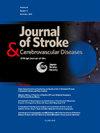Exploring the bidirectional relationships between alzheimer's disease and cerebral small vessel disease: Insights from mendelian randomization
IF 2
4区 医学
Q3 NEUROSCIENCES
Journal of Stroke & Cerebrovascular Diseases
Pub Date : 2025-02-08
DOI:10.1016/j.jstrokecerebrovasdis.2025.108259
引用次数: 0
Abstract
Objective
This study aimed to elucidate the bidirectional causal relationships between Alzheimer's disease (AD), cerebral small vessel disease (CSVD), and the effect of inflammatory cytokines on AD and CSVD using Mendelian randomization (MR).
Method
We employed publicly available summary-level data from genome-wide association studies for AD, CSVD, and 91 inflammatory cytokines. Genetic variants strongly associated with each risk factor were selected as instrumental variables. The inverse variance weighted (IVW) method was primarily used for causal inference, with sensitivity analyses including MR-Egger and weighted median estimators.
Results
MR analysis revealed that genetically predicted CSVD significantly increased the risk of AD (odds ratio [OR] = 1.035, 95% CI, 1.015–1.056, P = 0.001). Conversely, AD did not significantly influence CSVD risk (OR = 0.878, 95% CI, 0.701–1.100, P = 0.257). Among inflammatory cytokines, Axin1 (OR = 1.082, 95% CI, 1.009–1.159, P = 0.026) and bNGF (OR = 1.061, 95% CI, 1.001–1.125, P = 0.048) increased AD risk, while CD5 (OR = 0.937, 95% CI, 0.887–0.991, P = 0.022) and CXCL11 (OR = 0.951, 95% CI, 0.912–0.992, P = 0.019) decreased AD risk. FGF19 (OR = 0.560, 95% CI, 0.405–0.773, P < 0.001) and TNFSF14 (OR = 0.744, 95% CI, 0.580–0.954, P = 0.020) were protective against CSVD.
Conclusion
Our findings suggest that CSVD may increase AD risk, while specific inflammatory cytokines exhibit differential associations with these conditions. Targeting vascular health and inflammation may offer promising therapeutic avenues for managing neurodegenerative diseases.
研究目的本研究旨在利用孟德尔随机化法(MR)阐明阿尔茨海默病(AD)、脑小血管病(CSVD)之间的双向因果关系,以及炎性细胞因子对AD和CSVD的影响:我们采用了公开的全基因组关联研究的摘要级数据,这些数据涉及AD、CSVD和91种炎症细胞因子。我们选择了与各风险因素密切相关的基因变异作为工具变量。因果推断主要采用反方差加权法(IVW),敏感性分析包括 MR-Egger 和加权中位数估计:MR分析显示,遗传预测的CSVD会显著增加AD的风险(几率比[OR] = 1.035,95% CI,1.015-1.056,P = 0.001)。相反,AD 并不明显影响 CSVD 风险(OR = 0.878,95% CI,0.701-1.100,P = 0.257)。在炎性细胞因子中,Axin1(OR = 1.082,95% CI,1.009-1.159,P = 0.026)和 bNGF(OR = 1.061,95% CI,1.001-1.125,P = 0.048)会增加 AD 风险,而 CD5(OR = 0.937,95% CI,0.887-0.991,P = 0.022)和 CXCL11(OR = 0.951,95% CI,0.912-0.992,P = 0.019)会降低 AD 风险。FGF19(OR = 0.560,95% CI,0.405-0.773,P <0.001)和TNFSF14(OR = 0.744,95% CI,0.580-0.954,P = 0.020)对CSVD具有保护作用:我们的研究结果表明,心血管疾病可能会增加注意力缺失症的风险,而特定的炎症细胞因子与这些疾病的关系各不相同。针对血管健康和炎症可能为控制神经退行性疾病提供有前景的治疗途径。
本文章由计算机程序翻译,如有差异,请以英文原文为准。
求助全文
约1分钟内获得全文
求助全文
来源期刊

Journal of Stroke & Cerebrovascular Diseases
Medicine-Surgery
CiteScore
5.00
自引率
4.00%
发文量
583
审稿时长
62 days
期刊介绍:
The Journal of Stroke & Cerebrovascular Diseases publishes original papers on basic and clinical science related to the fields of stroke and cerebrovascular diseases. The Journal also features review articles, controversies, methods and technical notes, selected case reports and other original articles of special nature. Its editorial mission is to focus on prevention and repair of cerebrovascular disease. Clinical papers emphasize medical and surgical aspects of stroke, clinical trials and design, epidemiology, stroke care delivery systems and outcomes, imaging sciences and rehabilitation of stroke. The Journal will be of special interest to specialists involved in caring for patients with cerebrovascular disease, including neurologists, neurosurgeons and cardiologists.
 求助内容:
求助内容: 应助结果提醒方式:
应助结果提醒方式:


